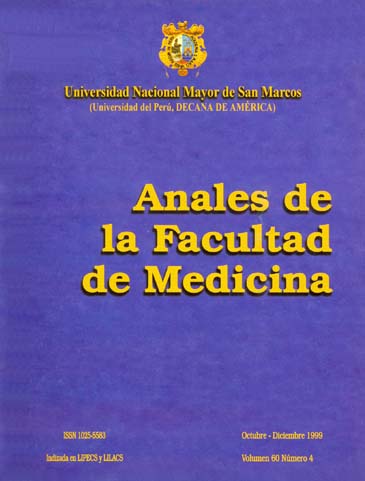Extracellular Aspects on N-Metyl-D-Aspartate (Nmda) Glutamate Receptor in Schizophrenia
DOI:
https://doi.org/10.15381/anales.v60i4.4385Keywords:
Schizophrenia, Receptor, N-metil-D-Aspartato, Cerebrospinal FluidAbstract
OBJECTIVE: To determine the relationship between extracellular levels of pH, Ca2+ and Mg2+ and schizophrenia, regarding the glutamate N-metyl-D-Aspartate (NMDA) receptor-hypofunction theory as primary mechanism in the etiology of schizophrenia. MATERIAL AND METHODS: Cerebrospinal fluid (CSF) pH, Ca2+ and Mg2+ levels were measured in 10 schizophrenic inpatients with antipsychotic treatment diagnosed according to the ICD-10, at the Hospital Rebagliati Mental Health Department in Lima, Peru, and 7 non psychiatric patients. RESULTS: pH levels from schizophrenic group (6,95 ± 0,06) wese significantly lower than control group ones (7,30 ± 0,12) (difference: 0,35 units) (p <0,005). Ca2+ levels were 0,14 mg/dL lower in schizophrenic group (4,44 ± 0,47 mg/dL) than in control group (4,58 ± 0,21 mg/dL) (p >0,05). Mg2+ leves were also lower in the schizophrenic group (1,61 ± 0,67 mg/dL) compared with control group (1,58 ± 0,26 mg/dL) (difference: 0,03 mg/dL, p >0,05). CONCLUSIONS: These findings suggest that diminished pH in schizophrenic patients CSF may be one of the mechanisms involved in the NMDA receptor-hypofunction described in schizophrenia.Downloads
Published
1999-12-31
Issue
Section
Trabajos originales
License
Copyright (c) 1999 Pío Zelaya Castro

This work is licensed under a Creative Commons Attribution-NonCommercial-ShareAlike 4.0 International License.
Those authors who have publications with this magazine accept the following terms:
- Authors will retain their copyrights and guarantee the journal the right of first publication of their work, which will be simultaneously subject to Creative Commons Attribution License that allows third parties to share the work as long as its author and its first publication this magazine are indicated.
- Authors may adopt other non-exclusive licensing agreements for the distribution of the version of the published work (eg, deposit it in an institutional electronic file or publish it in a monographic volume) provided that the initial publication in this magazine is indicated.
- Authors are allowed and recommended to disseminate their work over the Internet (eg: in institutional telematic archives or on their website) before and during the submission process, which It can produce interesting exchanges and increase quotes from the published work. (See El efecto del acceso abierto ).
How to Cite
1.
Zelaya Castro P. Extracellular Aspects on N-Metyl-D-Aspartate (Nmda) Glutamate Receptor in Schizophrenia. An Fac med [Internet]. 1999 Dec. 31 [cited 2025 Jun. 7];60(4):265-74. Available from: https://revistasinvestigacion.unmsm.edu.pe/index.php/anales/article/view/4385



